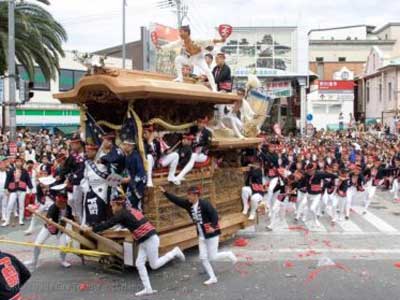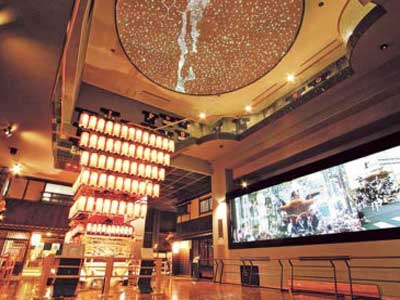The very lively Danjiri Matsuri festival is held twice in one year. In late September and early October, the Osaka festival erupts in the streets of the Kishiwada neighborhood. This local festival is very fun to watch, and if you happen to be around when it is held, you should definitely stop by!
History of the Danjiri Matsuri in Osaka
The festival is said to have its origin in the Inari Matsuri held in the 16th year of the Genroku era (1703). The festival was created by the Lord of Kishiwada Castle to pray for an abundant harvest. And it has from its very beginning enjoyed great local support.
The Danjiri Matsuri quickly grew in significance for the people of Kishiwada. Gates normally barring townspeople from entering the castle grounds were thrown open on festival days. Feudal lords of Kishiwada looked on as each Danjiri was drawn in. And each Danjiri pulling team staged various, high-spirited performances.
34 Danjiri teams bring their sacred float on a ‘recklessly’ swift tour of this castle town. It is a race of strength, endurance, and celebration. Each Danjiri is hand-made entirely of zelkova wood. One float weighs about 4 tons, is 3,8 meters high, 4 meters long and 2.5 meters wide. The draw-rope is from 100 to 200 meters in length and is pulled by as many as 500 to 1000 people.


Important Danjiri Terms
Hiki-dashi (Opening pull): The opening of the Danjiri Matsuri with high spirits and speed. Danjiris in tow, all 34 Danjiri teams begin a mad dash around the streets of Kishiwada. The sound of the siren comes at 6 am, which is when they all spring into action.
Yari-mawashi (Corner turning): Working both front and rear levers in unison, Danjiri teams literally “skid” their heavy Danjiris around each street corner. Done quickly to the beat of drums and shouts of the pulling team, corner turning is one of the most dramatic elements of the festival.
Horimono (Wood carvings): Each of the massive Danjiri is adorned with a number of intricate wood carvings. The carvings depict celebrated battles and records of war in ancient Japan.
Miya-iri (Going to worship at the shrine): In the morning on the second day, 34 Danjiri are divided into three groups. This is the day that they go to worship at the three major Shinto shrines in Kishiwada.
Hi-iri Ei-kou (Parade of lantern-lit Danjiris): In the evenings, brilliant sails of red lanterns are affixed to each of the Danjiris. Then they begin a slow procession along the main parade route. As the pace becomes leisurely, the bright lanterns and costumes and the rhythmic drums and chants blend. Together with the sounds and smells of the night vendors, they produce a wonderfully different experience. An evening matsuri.
Locally Organized Festival
The citizens of Kishiwada are proud to hail the Danjiri Matsuri of Kishiwada as the greatest of its kind in Japan. Townspeople, from the youngest to the oldest, take part in the festival with duties assigned to them according to age. Each Danjiri team is organized and managed by a particular ‘cho’, an area within the community covering a certain number of blocks. Few examples of traditional cultural festivals of this size and of this degree of organized participation still exist in Japan today.
If you are not in Osaka when the festival is held but still want to get a taste of it, you can visit the Danjiri Kaikan museum. This museum is open year-round and gives a nice idea of what the atmosphere must be like during the actual festival.
Your Japan Tour
As seasoned Japan experts, we create perfect Japan package tours including destinations like Osaka. Check out our group tours and private tours, or contact us to start planning your unforgettable holiday to this fascinating country. Japan is full of once-in-a-lifetime experiences, culture, history, nature, and delicious food!